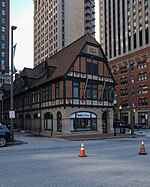Pratt Street

Pratt Street is a major street in Baltimore, Maryland, United States. It forms a one-way pair of streets with Lombard Street that run west–east through downtown Baltimore. For most of their route, Pratt Street is one-way in an eastbound direction, and Lombard Street is one way westbound. Both streets begin in west Baltimore at Frederick Avenue and end in Butcher's Hill at Patterson Park Avenue. Since 2005, these streets have been open to two-way traffic from Broadway until their end at Patterson Park. Although Lombard is also a two-way street from Fulton Avenue to Martin Luther King Jr. Boulevard, Pratt is still one-way eastbound in this area. To the east of Patterson Park, both Pratt and Lombard Streets start again. Pratt continues as a side street from Linwood Avenue until Haven Street. Pratt Street has historic significance as the location of the Baltimore Riot of 1861. Today it is known for being an important gateway into the Inner Harbor, connecting it with the Baltimore Light Rail line. It is for the latter reason that the city decided to redesign the street and surrounding area to be more pedestrian-friendly. Pratt Street is named for Charles Pratt, 1st Earl Camden a supporter of Civil liberties in the 18th century, and not the noted Baltimorean Enoch Pratt (1808–1896). Pratt Street appears on maps of Baltimore as early as 1801.Pratt Street was ranked the 33rd "most expensive city street" in the United States.Notable landmarks on or near Pratt Street include: Runs through Little Italy Oriole Park at Camden Yards (nearby) Baltimore Convention Center Inner Harbor/Harborplace and the Gallery National Aquarium The Power Plant B&O Railroad Museum Camden Station 100 East Pratt Street University of Maryland, Baltimore Reginald F. Lewis Museum of Maryland African American History & Culture Flag House & Star-Spangled Banner Museum Baltimore Freedom Academy Stratford University
Excerpt from the Wikipedia article Pratt Street (License: CC BY-SA 3.0, Authors, Images).Pratt Street
East Pratt Street, Baltimore
Geographical coordinates (GPS) Address Nearby Places Show on map
Geographical coordinates (GPS)
| Latitude | Longitude |
|---|---|
| N 39.286519444444 ° | E -76.613527777778 ° |
Address
100 East Pratt Street
East Pratt Street 100
21202 Baltimore
Maryland, United States
Open on Google Maps








